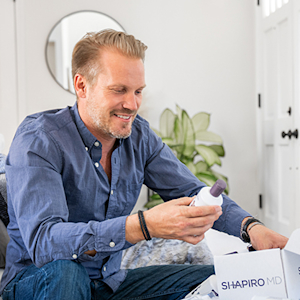Which Minoxidil Is Best? Minoxidil Concentrations Explained
2021-06-16
First created 50 years ago to treat stomach ulcers, Minoxidil (2,4-diamino-6-piperidinopyrimidine 3-oxide) was ultimately found to be ineffective against ulcers -- but highly effective for dilating blood vessels. Based on this development, the U.S. FDA approved Minoxidil tablets for severe hypertension in the early 1980s.
Several studies conducted prior to FDA approval of Minoxidil discovered a harmless but unique side effect of the drug--hair growth in individuals experiencing hair thinning and baldness. By the mid 1980s, doctors had seen enough reliable evidence to begin prescribing Minoxidil (brand name Loniten at that time) as an off-label medication for people with hair loss.
In 1988, the FDA approved Minoxidil for male pattern baldness under the now-famous trade name of Rogaine. Three years later, Rogaine was approved for use in women with female pattern hair loss.
Hair Loss Conditions Treated with Minoxidil
Minoxidil (Rogaine) is the most popular over-the-counter treatment for androgenic alopecia, or male and female pattern hair loss attributed to genetics and hormones. Other hair loss disorders where minoxidil may help stimulate hair grown include telogen effluvium, alopecia areata and loose anagen hair disorder.
People who use topical minoxidil must apply the solution twice daily to stimulate hair follicle health and hair growth. Minoxidil's mechanism of action is not clearly understood but is believed to involve the drug's ability to dilate blood vessels, open potassium channels and allow blood nutrients to reach hair follicles. Additionally, minoxidil is a nitric oxide agonist, which seems to promote telogen phase in follicles. More hairs are shed during this follicle phase than other phases. Consequently, it's easier and faster for lost hairs to be replaced by thicker, stronger anagen-phase hair encouraged by minoxidil use.
What is Androgenic Alopecia?
Excessive amounts of the hormone dihydrotesterone (DHT) may inactivate hair follicles, leading to thinning hair or hair loss. DHT dysregulation is typically caused by genetics, prostate enlargement and/or steroid use. Men in their 20s and 30s with receding hairlines, balding on top of the head, or general hair loss are commonly diagnosed with androgenic alopecia.
A telltale sign of male pattern baldness is the shape of bald areas on a man's head. As hair loss increases, a horseshoe pattern often develops encircling the head. When the pattern becomes unmistakable, this indicates advanced androgenic alopecia that will likely lead to complete baldness without treatment.
Female pattern baldness is also called androgenic alopecia. An inherited condition, female pattern baldness often accelerates after menopause as estrogen and progesterone levels plummet. While most women with androgenic alopecia do not lose all of their hair, they can lose hundreds of individual hairs each day and develop a receding hair line. Some women may have areas of hair loss on top of their head through which their scalp can be seen.
What is the Difference Between Minoxidil 2% and Minoxidil 5%?
Minoxidil 2% is simply a weaker version of minoxidil 5%. Results of a 48-week, placebo-controlled, randomized trial comparing topical minoxidil solution 2% with topical minoxidil solution 5% found that 5% minoxidil was "significantly superior" to 2% minoxidil and a placebo for increasing hair regrowth. The authors of this study also reported improvement in subjects' "psychosocial awareness of hair loss" which led to better self-esteem. The only side effect noted was occurrences of local skin irritation in study participants using 5% minoxidil.
All participants in this trial were men with androgenic alopecia (male-pattern hair loss). During the final week of the study (week 48), men using 5% minoxidil had 45% more hair growth than men using 2% minoxidil. Both 2% and 5% minoxidal were well-tolerated, and no systemic side effects were reported.
A 2007 study published in the Journal of American Academy of Dermatology involved an investigation into an alternative form of minoxidil--propylene foam without glycol.
To determine the effectiveness of Minoxidil foam over cream, researchers conducted a 16-week, placebo-controlled, double-blind trial using 5% minoxidil foam on 352 men with male-pattern baldness.
Results of this trial showed a statistically significant increase in hair count (regrowth) in men applying 5% minoxidil versus the placebo.
Subjective evaluations of men experiencing hair regrowth revealed strong satisfaction with the results. In addition, no adverse effects were seen in this trial, which led researchers to conclude that this 5% minoxidil foam was an effective and safe treatment for men with male-pattern baldness.
Minoxidil and Women with Female-pattern Baldness
To determine the efficacy of minoxidil 2% vs minoxidil 5% in women with androgenic alopecia, researchers conducted a 48-week, placebo-controlled trial involving 381 women with female pattern hair loss. Results indicated that after 48 weeks, the minoxidil 5% group "demonstrated superiority" over the placebo and Minoxidil 2% groups. However, unlike trials with men using minoxidil 5%, the female subjects in this study reported mild hypertrichosis (abnormal hair growth) and pruritis (itchiness) in addition to local irritation.
Efficacy of Oral Minoxidil
Optimizing hair regrowth with minoxidil requires patients apply the solution twice a day to the scalp. Due to patient noncompliance with applying minoxidil more than once a day, manufacturers have investigated the effectiveness of minoxidil in once-a-day oral form.
A study published in the American Academy of Dermatology evaluated the use of oral minoxidil at 2% or less by summarizing the results of 17 studies i a review. Most studies involved subjects with androgenic alopecia, with a minimal number involving people with alopecia areata, loose anagen hair syndrome and telogen effluvium.
Results showed that low dose oral minoxidil is well-tolerated and effective for individuals who have problems adhering to twice-daily applications of topical minoxidil. However, since the majority of studies have shown that topical 5% minoxidil is more effective than 2% minoxidil in treating hair loss, oral minoxidil may not work as well for some people with persistent hair loss.
What about the FDA?
Minoxidil 5% vs Minoxidil 10%
Currently, the FDA has only approved topical minoxidil 5% and minoxidil 2% for treating hair loss. Minoxidil 10% has not been FDA approved due to lack of studies investigating the full range of effects of minoxidil 10%. This is why minoxidil 10% is only available via prescription from a licensed doctor or dermatologist.
While minoxidil sulfate (the active ingredient in Minoxidil) is harmless, the extra inactive ingredients found in higher doses of minoxidil may cause itchiness and skin irritation. Propylene glycol and alcohol may promote dry skin and atopic dermatitis in people with sensitive scalp skin. It would follow then that minoxidil 10% is likely to induce side effects in more people than minoxidil 2% and 5%.
Which Minoxidil is Best?
When it comes to which minoxidil concentration is best, most dermatologists will recommend that women stick with minoxidil 2% and men with minoxidil 5%, both of which are available over-the-counter. Clinicians can and do prescribe higher concentrations for the right patients, though this requires a medical professional's help.
That's where Shapiro MD comes in. We help men and women order custom prescription hair loss solutions from home shipped to their door if prescribed and with ongoing access to their Shapiro MD professional.


